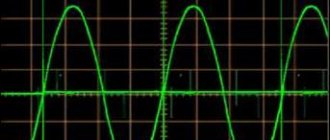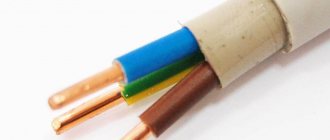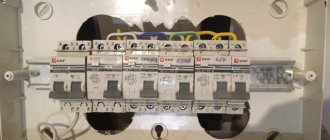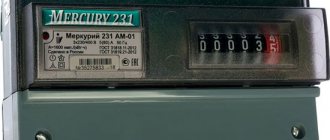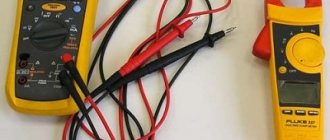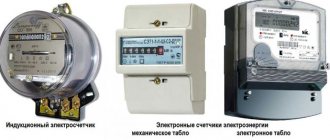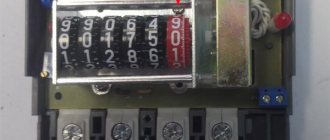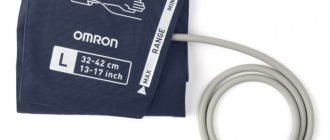No instrument in the world is accurate. The value that it measures will always differ from the truth by the amount that is also called its error. This error will determine the accuracy class of the ammeter. The task of all manufacturers of measuring equipment is to ensure that this error is as low as possible and tends to zero.
The error of an ammeter is established as a result of verification and comparison of measurement readings of the same quantities with a reference or reference device that has a higher accuracy class. In this case, the value obtained on the reference device is considered valid.
V. Accuracy of measuring instruments.
The accuracy of a measuring device is its property that characterizes the degree of approximation of the readings of a given measuring device to the actual values of the measured value and is determined by the smallest value that can be determined reliably using this device.
The accuracy of the device depends on the value of the smallest division of its scale and is indicated either on the device itself or in the factory instructions (passport). Note that the measurement accuracy
is inversely proportional to the relative measurement error E: = .
The error of electrical measuring instruments is determined by the accuracy class (or reduced error Epr), which is indicated on the front side of the device with the corresponding number in a circle. The accuracy class of an instrument K is the ratio of the absolute error expressed as a percentage
to the limiting (nominal) value of the xpr of the measured value, i.e. to its greatest value that can be measured on the instrument scale (measurement limit):.
Knowing the accuracy class and measurement limit of the device, you can calculate its absolute error:
.
This error is the same for any measurement made using this device. Seven accuracy classes: 0.1; 0.2; 0.5; 1.0; 1.5; 2.5; 4.0. Devices of the first three accuracy classes (0.1; 0.2; 0.5) are called precision
and are used for precise scientific measurements, instruments of other accuracy classes are called
technical
. Devices without indicating the accuracy class are considered extracurricular.
Example . The current strength is measured in the circuit with an ammeter, the accuracy class of which is K = 0.5, and the scale has a measurement limit Ipr = 10 A. We find the absolute error of the ammeter:
It follows that the ammeter allows you to measure current with an accuracy of no more than 0.05 A, and therefore it is inappropriate to make a reading on the instrument scale with greater accuracy.
Let's assume that three current values were measured using this ammeter: I1=2 A; I2=5 A; I3=8 A. We find the relative error for each case:
; .
From this example it follows that in the third case the relative error is the smallest, that is, the larger the reading value on the device, the smaller the relative measurement error. That is why, for optimal use of instruments, it is recommended to select them so that the value of the measured value is at the end of the instrument scale. In this case, the relative error approaches the accuracy class of the device. If the accuracy of the device is unknown, then the absolute error is taken equal to half the value of the smallest division (ruler, thermometer, stopwatch). For calipers and micrometers – the accuracy of their verniers (0.1 mm, 0.01 mm).
Notes: 1) When making readings, make sure that the line of sight is perpendicular to the scale. To eliminate the so-called parallax error, many devices are equipped with a mirror (“mirror devices”). The experimenter's eye is positioned correctly if the instrument needle covers its image in the mirror.
2) For indirect measurements (for example, determining the volume of a cylinder by its diameter and height), all measured vertices should be determined with approximately the same relative accuracy.
3) When processing measurement results, it should be remembered that the accuracy of calculations must be consistent with the accuracy of the measurements themselves. Calculations performed with more decimal places than necessary result in a lot of unnecessary work. For example, if at least one of the quantities in any expression is defined with an accuracy of two significant figures, then there is no point in calculating the result with an accuracy of more than two significant figures. At the same time, in intermediate calculations it is recommended to save one extra digit, which later - when recording the final result - will be discarded. In the theory of errors, there is the following exception to the existing rounding rules: when rounding errors, the last digit retained is increased by one if the highest discarded digit is 3 or greater than 3.
4) Examples of final recording of measurement results:
ACCURACY OF MEASUREMENT INSTRUMENTS
The quality of a measuring device is characterized by its accuracy, which is assessed by the measurement error.
From the consideration of the above, it follows that impeccably accurate measurement of electrical quantities is technically impossible, i.e. the true value of the measured quantity cannot be determined using a measuring instrument. Therefore, the actual value of the measured quantity is taken as the true value.
The difference between the value of the quantity measured using the working device a
,, and its true value
a
is called the absolute measurement error:
The smaller the absolute error in comparison with the measured value, the higher the quality of the measurement. To characterize the measurement quality, the relative measurement error is introduced:
Since the magnitudes ai ah
differ little from each other, then often instead of
a
we substitute the value
a„
obtained directly from experience. The value of the absolute measurement error is influenced mainly by the error in readings, imperfection of measurement methods and the error of the instruments themselves.
Errors of electrical measuring instruments are divided into basic and additional. The main errors characterize the quality of the device itself; additional errors are caused by deviations of operating conditions from normal ones. The ratio of the largest value of the basic absolute error to the upper limit of measurement of the device determines the quality of the device itself. This ratio is called the reduced error. The given error is usually expressed as a percentage, and according to the value of the given error, all devices are divided into 8 accuracy classes: 0.05; 0.1; 0.2; 0.5; 1; 1.5; 2.5; 4.0. Devices that have a reduced error of more than 4% are considered extracurricular (these are panel and educational devices). However, the accuracy class of the device does not determine the accuracy of the measurement itself. To prove this position in the case where the absolute error does not depend on a
, multiply and divide the expression for the relative error by the upper limit of measurement am:
Determination of accuracy class.
In order to use high-quality equipment for measuring various quantities, it is necessary to know the error with which this particular device makes measurements. The technical characteristics of any measuring instrument include the following indicators, which are usually indicated on the scale:
- unit of measurement of a quantity that the device determines;
- operating principle system (magnetoelectric, electromagnetic, induction and others)
- instrument accuracy class;
- position of the device scale (horizontal, vertical or inclined);
- voltage at which the housing insulation test was carried out;
- serial number and year of manufacture.
- the type of current at which it is necessary to carry out measurements (direct, alternating).
One of the characteristics of a technical measuring instrument is the accuracy class - a value determined by several errors, namely their limits. The formula for determining this device characteristic is as follows:
γ = ΔXmax / Xpr⋅× 100%, where
ΔXmax – maximum absolute measurement error;
Xpr – the highest value on the instrument scale.
The accuracy class of the device is also called the reduced error. According to this indicator, all measuring devices are divided into eight classes:
Devices that have such groups of errors are called precision, from the English word “precision”, which means accuracy when translated into Russian. These are the most accurate devices and are used in laboratory research.
The following four accuracy classes:
They are used in the technical industry, and they are called technical.
Manufacturers of measuring technical devices indicate its accuracy class on the scale; if there is no mark, the device is considered extracurricular, and its measurement error is more than 4%.
The accuracy class of instruments is a characteristic of the accuracy of the devices themselves, but this indicator does not determine the accuracy of the measurements taken. For example, the accuracy class of ammeters is characterized by absolute error limits and does not guarantee that these readings will not be adjusted by indicators such as the effect of a magnetic field, alternating current frequency and temperature changes, as well as other external stimuli.
Accuracy classes of instruments can be indicated either in Latin letters or in Arabic or Roman numerals. Numerical Arabic values mean that the main indicator of accuracy is the reduced error and the largest and smallest values of a series of measurements must be taken into account. The Roman numeral when designating the accuracy class indicates that the accuracy of the device was determined by the value of the relative error.
If, when marking the accuracy class of a device, a fractional number is indicated on the scale (for example, “0.01/0.02”), this means that the given error at the maximum scale is ±0.01%, and at the beginning ±0.01 %. This is applicable in high-frequency electrical measuring instruments.
What are they used for?
Various types of instrument transformers are found both in small matchbox-sized devices and in large power installations. Their main purpose is to reduce primary currents and voltages to the values required for measuring devices, protective relays and automation. The use of step-down coils provides protection for the lower and higher rank circuits, since they are separated from each other.
Reducing agents are divided according to characteristics of operation and are intended for:
Measurement
An instrument transformer is necessary to reduce the high current of the main voltage and transfer it to measuring devices. Connecting standard devices to a high-voltage network would require cumbersome installations. It is neither economically profitable nor advisable to sell instruments of this size.
The use of step-down transformers allows the use of conventional measuring devices in normal mode, which expands the range of their applications. Due to the reduced voltage, they do not require additional modifications. The transformer separates the high-voltage network voltage from the supply voltage of the devices, ensuring safety from use. The accuracy of electrical energy metering depends on their class.
Protection
In addition to powering measuring instruments, step-down transformers supply voltage to protection and automatic blocking systems. Because voltage drops and surges occur in the network electrical network, which is detrimental to high-precision circuit equipment.
In power plants, equipment is divided into power and secondary, which controls the processes of the primary device connection circuit. High-voltage equipment is located in open areas or devices. Secondary equipment is located on relay strips inside distribution cabinets.
The intermediate element for transmitting information between power units and measuring, control, monitoring and protection devices are step-down or instrument transformers. They separate the primary and secondary circuits from the harmful effects of power units on sensitive measuring instruments, and also protect operating personnel from damage.
Accuracy class
During laboratory measurements, it is necessary to know the accuracy of the measuring instruments, which in turn have certain characteristics and differ in design. Each of the measuring instruments (MI) has certain inaccuracies, which are divided into basic and additional. Situations often arise when it is not possible or simply not required to make a detailed calculation. Each measuring instrument is assigned a certain accuracy class, knowing which, you can find out its range of deviations.
Normalized error values will help you find out the errors of the measuring instrument in a timely manner. This definition should be understood as the limiting indicators for a measuring instrument. They can be different in size and depend on different conditions, but they should not be neglected in any case, because this can lead to a serious mistake in the future. The normalized values should be less than what the device shows. The limits of permissible error values and the necessary coefficients are entered in the passport of each dimensional measuring device. You can find out detailed standardization values for any device using the corresponding GOST.
What is an ammeter and what quantities does it measure?
An ammeter is a measuring device that is used to measure current [I] in electrical circuits. The SI unit of [I] is ampere [A]. Electric circuits can conduct current of different strengths, therefore the instrument scale of the ammeter is calibrated with different gradations from a microampere equal to 1 μA = 1 × 0 -6 amperes to a kiloampere equal to: 1 kA = 1,000 amperes.
Important! The ammeter is connected in series to the electrical circuit, and to increase the measurement limit, special devices are used: transformers, shunts and magnetic amplifiers.
Since the current in the circuit directly depends on the resistance value [R] of the electrical circuit elements, the device’s own resistance [Ra] must be extremely low, tending to zero. This will reduce the influence of the device in the process of measuring current in the circuit, thereby increasing the accuracy of the measurement.
Accuracy class of the measuring device
A generalized characteristic, which is determined by the limits of errors (both basic and additional), as well as other properties that influence accurate measurements and whose indicators are standardized, is called the accuracy class of the measuring apparatus. The accuracy class of measuring instruments provides information about a possible error, but at the same time it is not an indicator of the accuracy of a given SI.
A measuring instrument is a device that has standardized metrological characteristics and allows measurements of certain quantities. According to their purpose, they are exemplary and working. The first ones are used to control the second or exemplary ones, who have a lower qualification rank. Workers are used in various industries. These include measuring:
- devices;
- converters;
- installations;
- systems;
- accessories;
- measures.
Each measuring instrument has a scale on which the accuracy classes of these measuring instruments are indicated. They are indicated in the form of numbers and indicate the percentage of error. For those who do not know how to determine the accuracy class, you should know that they have been standardized for a long time and there is a certain series of values. For example, the device may have one of the following numbers: 6; 4; 2.5; 1.5; 1.0; 0.5; 0.2; 0.1; 0.05; 0.02; 0.01; 0.005; 0.002; 0.001. If this number is in a circle, then this is the sensitivity error. It is usually indicated for scale converters, such as:
- voltage dividers;
- current and voltage transformers;
- shunts.
Accuracy class designation
The limit of the operating range of this device, within which the value of the accuracy class will be correct, must be indicated.
Those measuring devices that have numbers next to the scale: 0.05; 0.1; 0.2; 0.5, are referred to as precision. Their scope of application is precise and particularly precise measurements in laboratory conditions. Devices marked 1.0; 1.5; 2.5 or 4.0 are called technical and, based on the name, are used in technical devices, machines, and installations.
It is possible that there will be no markings on the scale of such a device. In such a situation, the error given is considered to be more than 4%.
If the value of the device’s accuracy class is not underlined below with a straight line, this indicates that such a device is normalized by the reduced zero error.
Deadweight piston pressure gauge, accuracy class 0.05
If a scale displays positive and negative values and the zero mark is in the middle of such a scale, then you should not think that the error will be constant throughout the entire range. It will change depending on the value that the device measures.
If the measuring unit has a scale on which the divisions are displayed unevenly, then the accuracy class for such a device is indicated as a fraction of the scale length.
There are options for measuring devices with scale values in the form of fractions. The numerator of such a fraction will indicate the value at the end of the scale, and the number in the denominator at zero.
Selecting an ammeter based on metrological characteristics
The most common source of error when measuring current is that the ammeter has a non-zero input resistance. The voltage generated across the meter causes the voltage across the device under test to decrease. If the reduction is significant, it will result in significantly less current flowing. In other words, the meter does not show the current that is actually flowing in the network.
In order to minimize this error as much as possible, two main types of measurement architecture are used: shunt ammeters and feedback ones.
The error caused by a shunt meter, expressed as the ammeter's partial voltage divided by the output resistance.
Ammeters with feedback are closer to “ideal”. It produces voltage in the feedback path of the high gain op amp. This voltage is also proportional to the measured current, but does not appear at the input of the device. As a result, sensitive closed-loop meters such as electrometers and picoammeters have a voltage load typically limited to 200 µV.
For industrial measurements, analog panel-type ammeters are most often used. When choosing them, you should consider the following points:
- Type selection. When measuring I DC, you should choose a DC meter, that is, with a magnetoelectric measuring mechanism. When measuring AC current, you need to pay attention to the waveform and frequency. If it is a sinusoid, then only the effective value is measured, followed by conversion to the maximum or average value.
- Accuracy class. The higher the accuracy class of the meter, the higher its price, the more difficult its repair and metrological certification. Therefore, to perform most engineering measurements, an accuracy class of 1.5 is sufficient; you should not use standard or laboratory instruments.
- Selecting a scale. To take full advantage of the ammeter's accuracy class, the measured value must be in the range of 1/2
Important! Internal resistance is a determining value when choosing a meter. It should be taken according to the magnitude of the measured impedance, otherwise it will lead to large measurement errors. Since internal resistance reflects the power consumption of the meter itself, when measuring current, a device with internal resistance should be selected as low as possible.
Rationing
Accuracy classes of measuring instruments tell us information about the accuracy of such instruments, but at the same time it does not show the accuracy of the measurement performed using this measuring device. In order to identify in advance the error in the instrument readings, which it will indicate during measurement, people normalize the errors. To do this, they use already known normalized values.
Rationing is carried out according to:
Formulas for calculating absolute error according to GOST 8.401
Each device from a specific group of devices for measuring dimensions has a certain value of inaccuracies. It may differ slightly from the established standardized indicator, but not exceed the general indicators. Each such unit has a passport in which the minimum and maximum error values are recorded, as well as coefficients that have an impact in certain situations.
Regulatory documents
There are several regulatory and technical documents that regulate the concept of accuracy and error class. The first document is GOST 13600-68, which establishes general provisions for the division of measuring instruments, as well as possible options for standardizing metrological indicators. The standard does not regulate technical issues for each individual device; instructions must apply to them.
CT issues are also presented in GOST 8.401-80 “SI accuracy classes general requirements”. This is the main document for the metrological service, which verifies measuring instruments. The document leads to uniformity of characteristics of measuring instruments, which makes it possible to compare values and determine the complex error of measurement systems.
Types of marking
The accuracy classes of absolutely all measuring instruments are subject to marking on the scale of these same instruments in the form of a number. Arabic numerals are used to indicate the percentage of normalized error. The designation of the accuracy class in a circle, for example the number 1.0, indicates that the error in the device’s needle readings will be equal to 1%.
If the designation uses a tick in addition to the number, this means that the scale length is used as a normalizing value.
Latin letters for designation are used if it is determined by the limits of absolute error.
There are devices on the scales of which there is no information about the accuracy class. In such cases, the absolute should be equated to one half of the smallest division.
Limits
As mentioned earlier, the measuring device, thanks to standardization, already contains random and systematic errors. But it is worth remembering that they depend on the measurement method, conditions and other factors. In order for the value of the quantity to be measured to be 99% accurate, the measuring instrument must have minimal inaccuracy. The relative one should be about a third or a quarter less than the measurement error.
Basic method for determining error
When setting the accuracy class, first of all, the limits of the permissible main error are subject to standardization, and the limits of the permissible additional error are a multiple of the main one. Their limits are expressed in absolute, relative and reduced form.
The reduced error of a measuring instrument is relative, expressed as the ratio of the maximum permissible absolute error to the standard indicator. Absolute can be expressed as a number or binomial.
If the SI accuracy class is determined through absolute, then it is denoted by Roman numerals or Latin letters. The closer the letter is to the beginning of the alphabet, the smaller the permissible absolute error of such a device.
Accuracy class 2.5
Thanks to the relative error, you can assign an accuracy class in two ways. In the first case, the scale will show an Arabic numeral in a circle, in the second case, a fraction, the numerator and denominator of which indicate the range of inaccuracies.
The main error can only occur under ideal laboratory conditions. In life, you have to multiply data by a number of special coefficients.
Additional occurs as a result of changes in quantities that in some way affect the measurements (for example, temperature or humidity). Exceeding the established limits can be identified by adding up all the additional errors.
Random errors have unpredictable values due to the fact that the factors influencing them are constantly changing over time. To take them into account, they use the theory of probability from higher mathematics and keep records of previously occurring cases.
Example of error calculation
The statistical value of a measuring instrument is taken into account when measuring a constant or a quantity that is rarely subject to change.
Dynamic is taken into account when measuring quantities that often change their values over a short period of time.

